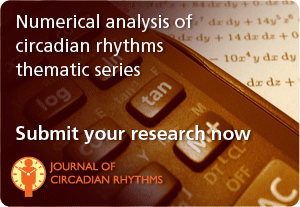 The numerical analysis of time series is essential for the documentation and characterization of biological rhythmicity, and proper data analysis is therefore fundamental to the study of circadian rhythms. There are numerous methods available for the analysis of time series, from classical methods such as spectral and cosinor analysis, to more modern techniques such as Bayesian parameter estimation for noisy sinusoids.
The numerical analysis of time series is essential for the documentation and characterization of biological rhythmicity, and proper data analysis is therefore fundamental to the study of circadian rhythms. There are numerous methods available for the analysis of time series, from classical methods such as spectral and cosinor analysis, to more modern techniques such as Bayesian parameter estimation for noisy sinusoids.
Journal of Circadian Rhythms has launched a new thematic series on the numerical analysis of circadian rhythms, which aims to provide informative reviews on the wide range of methods currently in use, and interesting research demonstrating how these methods can be used to extract valuable data.
The first article published in the series, by Tanya Leise, provides a comprehensive review of the wavelet analysis methods that can be used to identify circadian and ultradian patterns over the course of either one day, or day-to-day. Leise notes that wavelet analysis methods can be advantageous in some cases when used appropriately, but results may not prove useful if for example, the time series is too noisy or there is not sufficient amount of data. In the series’ latest article, Harold Dowse describes the advantages of using Maximum Entropy Spectral Analysis (MESA) and how it tackles some of the problems that the Fourier analysis presents.
The series aims to publish both solicited and unsolicited contributions. Pre-submission enquires are welcome and should be sent to editor@circadian.org. Manuscripts should be submitted via the journal’s online submission system.
Latest posts by Laura Winton (see all)
- Biology of Sex Differences introduces annual award for best OSSD member publication - 9th December 2013
- Molecular and Cellular Therapies launches with BioMed Central - 6th November 2013
- Musculoskeletal Aging thematic series –lifelong exercise training can attenuate genome instability - 19th July 2013
We now have published testing for Circadian Light
https://www.omicsonline.org/a-working-threshold-for-acute-nocturnal-melatonin-suppression-from-white-light-sources-used-in-architectural-applications-2157-2518.1000150.php?aid=19503
This should help us define night time public space, and especially work space where in some facilities, there are merely moments between work time and rest time. There is more detail to come.